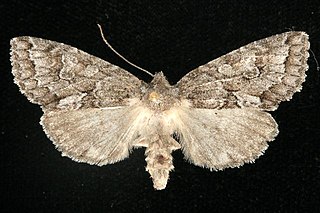Acronicta dolli, or Doll's dagger moth, is a species of moth in the family Noctuidae. It was first described by William Barnes and James Halliday McDunnough in 1818 and it is found in North America.

Eudocima serpentifera is a species of fruit-piercing moth in the family Erebidae first described by Francis Walker in 1858. It is found in North America.
Datana ranaeceps, the post-burn datana, is a species of moth in the family Notodontidae. Other common names include the heart-leaved catchfly and ranaeceps datana moth. It was first described by Félix Édouard Guérin-Méneville in 1844 and it is found in North America.

Clostera brucei, the Bruce's prominent moth or Bruce's chocolate-tip, is a species of moth in the family Notodontidae. It was first described by Henry Edwards in 1885 and it is found in North America.
Ursia noctuiformis is a species of moth in the family Notodontidae. It was first described by William Barnes and James Halliday McDunnough in 1911 and it is found in North America.
Oligocentria alpica is a species of moth in the family Notodontidae. It was first described by Foster Hendrickson Benjamin in 1932 and it is found in North America.
Lythrodes venatus is a species of moth in the family Noctuidae. It is found in North America.
Caradrina mona is a species of cutworm or dart moth in the family Noctuidae. It was first described by William Barnes and James Halliday McDunnough in 1912 and it is found in North America.
Oslaria pura is a species of moth in the family Noctuidae. It was first described by William Barnes and James Halliday McDunnough in 1911 and it is found in North America.
Lacinipolia spiculosa is a species of cutworm or dart moth in the family Noctuidae. It is found in North America.
Orthosia tenuimacula is a species of cutworm or dart moth in the family Noctuidae first described by William Barnes and James Halliday McDunnough in 1913. It is found in North America.
Anarta fulgora is a species of cutworm or dart moth in the family Noctuidae first described by William Barnes and James Halliday McDunnough in 1918. It is found in North America.
Nystalea eutalanta, or Dyar's tropical prominent moth, is a species of moth in the family Notodontidae. It was first described by Harrison Gray Dyar Jr. in 1921 and it is found in North America.
Homorthodes gigantoides is a species of cutworm or dart moth in the family Noctuidae first described by William Barnes and James Halliday McDunnough in 1912. It is found in North America.
Nacopa bistrigata is a species of moth in the family Noctuidae. It was first described by William Barnes and James Halliday McDunnough in 1918 and it is found in North America.
Proxenus mindara, the rough-skinned cutworm moth, is a species of cutworm or dart moth in the family Noctuidae. It was first described by William Barnes and James Halliday McDunnough in 1913 and it is found in North America.
Lineostriastiria hutsoni is a species of moth in the family Noctuidae. It is found in North America.
Xylomoia chagnoni, Chagnon's borer moth, is a species of cutworm or dart moth in the family Noctuidae. It was first described by William Barnes and James Halliday McDunnough in 1917 and it is found in North America.

Xylotype arcadia, the acadian sallow, is a species of cutworm or dart moth in the family Noctuidae. It was first described by William Barnes and Foster Hendrickson Benjamin in 1922 and it is found in North America.
Plagiomimicus ochoa is a species of moth in the family Noctuidae. It was first described by William Barnes in 1904 and it is found in North America.


